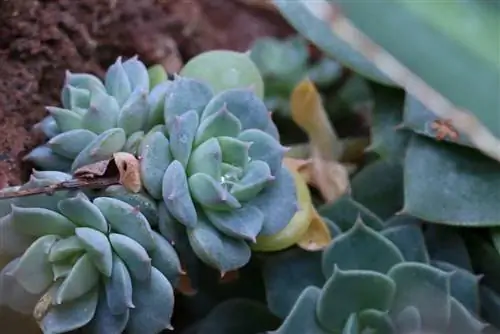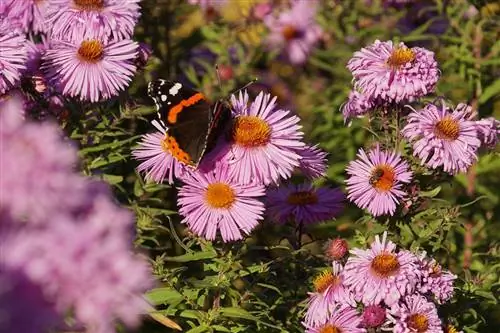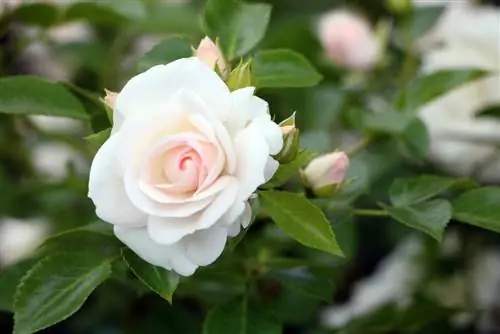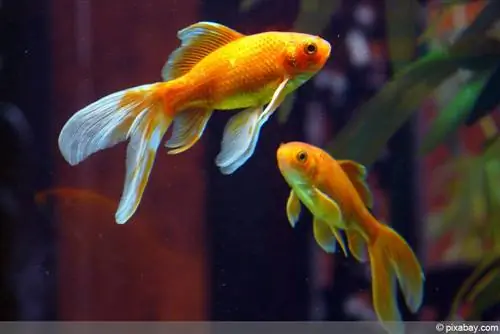- Author admin [email protected].
- Public 2023-12-17 03:39.
- Last modified 2025-06-01 06:48.
In the summer, the echeverias can beautify the balcony or garden, but they also thrive in the room. They forgive forgotten watering and are otherwise extremely frugal. In order for the echeverias to thrive, develop their full colors and even bloom, some special features must be taken into account when cultivating the thick-leaf plants. With a little knowledge, this is easy for beginners to do and doesn't require much effort. Therefore they are also ideal for people without a green thumb.
Location
Echeverias need a location with plenty of light. The brighter, the better. The blazing sun is optimal. A south-facing window or bright windows facing east or west are ideal in the room. In the garden, the plant should not be overshadowed by other plants. Added to this is the sensitivity to moisture. Echeverias like it dry, but they cannot cope with moist areas. The location should not be directly next to a body of water, under the leaky gutter, in the bathroom or in the kitchen.
Substrate
The warmth and drought-loving echeverias require permeable and loose soil that is still nutrient-rich. A mixture of compost and sand or perlite works well for them.
Tip:
Applying a 1 cm thick layer of bird sand or gravel to the substrate prevents the rosettes from resting and can thereby prevent mold and rot.
Plants & Culture in Pots
The Echeveria can be planted outdoors in spring, but is not hardy. If temperatures drop below 12 °C, it would therefore have to be dug up again. To make this easier, it makes sense to place the echeverias in a basket in the ground. However, it is much less complicated to cultivate them directly in the bucket.
Cultivation in a pot or bucket, as already mentioned, requires less effort in terms of care. The vessel does not have to be particularly high for this; a low bowl is sufficient. However, good water drainage is important. In order to avoid waterlogging, it is advisable to add a drainage layer. This can consist of coarse gravel or pottery shards.
Watering & Fertilizing
Although or precisely because the echeverias require little water, there are some special features when watering. The soil should dry well between waterings. If the Echeveria is kept too moist, the leaf colors will fade. In addition, the water should not get on the rosettes. If it collects here in the leaf axils, it can also lead to rot and mold.
If the echeverias were placed in fresh soil, they initially do well without additional nutrients. However, they should be fertilized from the second year onwards. Compost, which is worked superficially into the substrate, is well suited for this. Nettle manure or pond water can also be used. An occasional dose of coffee grounds will not harm them. The simplest option, however, is to use complete liquid fertilizer, which is added directly to the irrigation water. Fertilization begins in April. The last dose should take place in September. Watering can be used as a rule of thumb for frequency. Approximately every third to fifth time, a weak concentration of fertilizer can be administered.
Blend & overwintering
The Echeveria does not need a topiary or similar, but dried or wilted parts should be removed. In most cases it is not necessary to use scissors or a knife. It is better to tear out the relevant parts with a quick, violent tug. This means there are no leftovers that are unsightly and could rot. However, this should not be done timidly, as large parts often lift off the ground when pulled slowly.
The echeverias should be kept cool but frost-free over the winter. Temperatures of 5 °C to 15 °C are optimal. In addition, the winter quarters should be bright and also offer direct sunlight. Fertilization is completely stopped during the rest phase. Watering is done little by little and only when the substrate is in danger of drying out completely.
Tip:
Wintering warmly in a heated room is possible, but in most cases the Echeveria does not thrive.
Propagation & Repotting

Echeverias can be propagated in various ways. It is possible to grow seeds and root leaf cuttings and offshoots. But dividing the plant into whole rosettes can also lead to success; for this it is of course necessary that it has already formed several rosettes. This variant requires the least effort and works quickly. The following instructions show how to do it:
- The Echeveria are dug up in April or May and completely freed from the substrate.
- Divide the plant as centrally as possible while preserving the roots. If the echeverias have already grown well separated, only light pressure is required. For others, the use of a sharp knife may be necessary.
- The plant parts are now placed separately in fresh soil as deep as they were in the old one. Even now there is only a little water.
Tip:
If there are moist interfaces, they should first be allowed to air dry before the plants are replanted.
Repotting echeverias is only necessary when the substrate is used up or the plants have become too big for the pot. The only thing to remember is that the plants are not planted too deep in the soil. Spring is ideal as a time as well as for propagation.
Typical diseases, pests and care errors
Echeverias often suffer from root rot if they are watered too abundantly. Mold or rot on the rosettes themselves can also occur.
Pests can also occur, but show up less frequently. The most common species include aphids, scale insects and mealybugs. Since these are difficult to remove, using natural insecticides is the best choice.
Frequently asked questions
Why do Echeveria colors fade?
If the plant is watered too heavily or too often, the intensity of the leaf colors decreases. However, they regain this by reducing watering and drying out the substrate.
Are echeverias poisonous?
Depending on the exact species, Echeveria is at least slightly poisonous. Caution is advised, especially with broken leaves and possible skin contact. Children and pets should of course be kept away.
What you should know about echeverias in brief
- Echeveria elegans - this succulent should be cultivated at temperatures above 15 ºC.
- In summer it can go outside, in winter it can tolerate temperatures up to 5 ºC.
- The plant needs at least one hour of sunlight daily.
- Echeveria elegans is developing across the board. It spreads widely.
- When fertilizing, make sure to use low-nitrogen fertilizer.
- We only water in warm climates and then only if the soil has been dry for at least 2 days.
- Mostly it only needs to be watered every 4 to 5 weeks. Water must then be removed from the coaster.
- The soil must be well drained, soft and sandy.
Species
- Echeveria gibbiflora - likes it bright and sunny. It does not tolerate temperatures below 7 ºC or stagnant heat. It needs moderate water in summer and very little in winter. The soil must be nutrient-rich and well-drained. Waterlogging must be avoided at all costs.
- Echeveria pulvinata - is a quite demanding plant. The plant substrate should be mineral. The plant does not require much water. In winter you only moisten the soil every now and then so that the fine fibrous roots do not dry out. The new growth in spring is thus promoted. In full sun the color of the leaves changes and they really shine. Winter rest is recommended from November to March. The ideal temperatures are between 6ºC and 12ºC. Cactus soil and cactus fertilizer are well suited for keeping Echeveria pulvinata.
- Echeveria setosa - should be in partial shade and only receive full sun during the coolest hours of the day. The lower the temperatures, the less you have to water. However, temperatures should not fall below 15 ºC, not even at night. It is then better to bring the plant into the house. This thick leaf spreads by creeping. In winter the plant takes on a green-red color. In spring you should not put the Echeveria setosa outdoors too early. The temperature differences are still large and the frequent rain can cause fungal diseases. The fertilizer used should be rich in potassium and phosphorus.
- Echeveria runyonii - this succulent likes it warm and very sunny, like at home, in Mexico. The plant needs a relatively large amount of water in spring and summer, but almost none at all in winter. The leaves are water reservoirs and the plant then draws on this reservoir.






